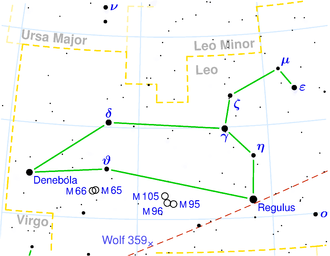Messier 95
| Galaxie Messier 95 | |
|---|---|
 | |
| Aufnahme der Balkenspiralgalaxie M 95 mit dem Very Large Telescope | |
| AladinLite | |
| Sternbild | Löwe |
| Position Äquinoktium: J2000.0, Epoche: J2000.0 | |
| Rektaszension | 10h 43m 57,7s[1] |
| Deklination | +11° 42′ 14″[1] |
| Erscheinungsbild | |
| Morphologischer Typ | SB(r)b / HII / Sbrst[1] |
| Helligkeit (visuell) | 9,8 mag[2] |
| Helligkeit (B-Band) | 10,6 mag[2] |
| Winkelausdehnung | 7,4′ × 5′[2] |
| Positionswinkel | 13°[2] |
| Flächenhelligkeit | 13,6 mag/arcmin²[2] |
| Physikalische Daten | |
| Zugehörigkeit | M96-Gruppe LGG 217[1][3] |
| Rotverschiebung | 0.002595 ± 0.000013[1] |
| Radialgeschwindigkeit | (778 ± 4) km/s[1] |
| Hubbledistanz vrad / H0 | (30 ± 2) · 106 Lj (9,3 ± 0,7) Mpc [1] |
| Geschichte | |
| Entdeckung | Pierre Méchain |
| Entdeckungsdatum | 20. März 1781 |
| Katalogbezeichnungen | |
| M 95 • NGC 3351 • UGC 5850 • PGC 32007 • CGCG 066-004 • MCG +02-28-001 • IRAS 10413+1158 • 2MASX J10435773+1142129 • GC 2184 • h 743 • | |
Messier 95 = NGC 3351 ist eine Balkenspiralgalaxie vom Hubble-Typ SB(r)b mit einer Flächenausdehnung von 7,4' × 5,0' im Sternbild Löwe an der Ekliptik. Sie ist schätzungsweise 30 Mio. Lichtjahre von der Milchstraße entfernt und wird als Starburstgalaxie klassifiziert. Die Galaxie gehört der Galaxiengruppe um Messier 96 (auch Leo-I-Gruppe genannt) an.
2012 konnte man die Supernova SN 2012aw in M95 beobachten mit einer Helligkeit von 13 mag.
Das Objekt wurde am 20. März 1781 von dem französischen Astronomen Pierre Méchain entdeckt.[4]
Aufnahme der Balkenspiralgalaxie M 95 mit dem Spitzer-Weltraumteleskop
Ultraviolettaufnahme von M 95 mittels GALEX
- (c) ESA/Hubble, CC BY 4.0
Detailaufnahme des Zentrums mithilfe des Hubble-Weltraumteleskops
Weblinks
- APOD
- Rings upon rings
- astronews.com: Bild des Tages 19. März 2012
- Spektrum.de: Umgebungskarte
Einzelnachweise
Auf dieser Seite verwendete Medien
Bildtafel der 110 Messier-Objekte. Diese Datei wird in der w:de:Template:Navigationsleiste Messierobjekte als Imagemap genutzt. Sie darf daher nicht durch eine andere Version überschrieben werden!
Autor/Urheber: Copyright © 2003 Torsten Bronger., Lizenz: CC BY-SA 3.0
This is a celestial map of the constellation Leo, the Lion.
Autor/Urheber: Franzferdinandgruber, Lizenz: CC BY-SA 3.0
Galaxie M95 mit Supernova SN 2012aw
(c) ESA/Hubble, CC BY 4.0
Rings upon rings
This image from the NASA/ESA Hubble Space Telescope reveals a spiral galaxy named Messier 95 (also known as M95 or NGC 3351). Located about 35 million light-years away in the constellation of Leo (The Lion), this swirling spiral was discovered by astronomer Pierre Méchain in 1781, and catalogued by French astronomer Charles Messier just four days later. Messier was primarily a comet hunter, and was often left frustrated by objects in the sky that resembled comets but turned out not to be. To help other astronomers avoid confusing these objects in the future, he created his famous catalogue of Messier objects.
Most definitely not a comet, Messier 95 is actually a barred spiral galaxy. The galaxy has a bar cutting through its centre, surrounded by an inner ring currently forming new stars. Also our own Milky Way is a barred spiral.
As well as hosting this stellar nursery, Messier 95 is a known host of the dramatic and explosive final stages in the lives of massive stars: supernovae. In March 2016 a spectacular supernova named SN 2012aw was observed in the outer regions of one of Messier 95’s spiral arms. Once the light from the supernova had faded, astronomers were able to compare observations of the region before and after the explosion to find out which star had “disappeared” — the progenitor star. In this case, the star was an especially huge red supergiant up to 26 times more massive than the Sun.
Credit:
ESA/Hubble & NASA
Coordinates Position (RA): 10 43 55.08 Position (Dec): 11° 41' 24.70" Field of view: 2.71 x 2.53 arcminutes Orientation: North is 15.8° left of vertical
Colours & filters Band Wavelength Telescope Optical UV 275 nm Hubble Space Telescope WFC3 Optical u 336 nm Hubble Space Telescope WFC3 Optical B 438 nm Hubble Space Telescope WFC3 Optical V 555 nm Hubble Space Telescope WFC3 Optical I 814 nm Hubble Space Telescope WFC3.
This image of galaxy NGC 3351, located approximately 30 million light-years away in the constellation Leo was captured by the Spitzer Infrared Nearby Galaxy Survey (SINGS) Legacy Project using the telescope's Infrared Array Camera (IRAC).
Autor/Urheber: ESO, Lizenz: CC BY 3.0
The Very Large Telescope has captured another member of the Leo I group of galaxies, in the constellation of Leo (The Lion). The galaxy Messier 95 stands boldly face-on, offering an ideal view of its spiral structure. The spiral arms form an almost perfect circle around the galactic centre before they spread out, creating a mane-like effect of which any lion would be proud.
Another, perhaps even more striking, feature of Messier 95 is its blazing golden core. It contains a nuclear star-forming ring, almost 2000 light-years across, where a large proportion of the galaxy’s star formation takes place. This phenomenon occurs mostly in barred spiral galaxies such as Messier 95 and our home, the Milky Way.
In the Leo I group, Messier 95 is outshone by its brother Messier 96 (see potw1143). Messier 96 is in fact the brightest member of the group and — as “leader of the pride” — also gives Leo I its alternative name of the M 96 group. Nevertheless, Messier 95 also makes for a spectacular image.Ultraviolet image of the face on barred and ringed spiral galaxy NGC 3351 (M95). The morphological appearance of a galaxy can change dramatically between visual and ultraviolet wavelengths. In the case of M95, the nucleus and bar dominate the visual image. In the ultraviolet, the bar is not even visible and the ring and spiral arms dominate.














